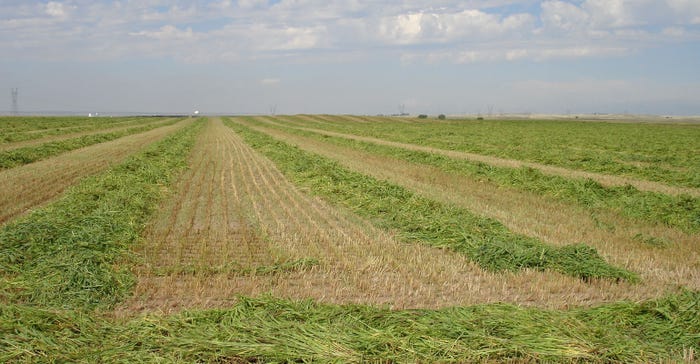July 27, 2017

Planting annual forages and harvesting it into windrows can be a win-win situation for producers who want to raise good-quality forage for their animals to graze. According to University of Nebraska Extension specialist Aaron Berger, cutting annual forages and leaving it in windrows is similar to putting up hay. "You can stop forage growth at an optimum, which allows you to hold the quality where you want it," he says. "This time of year, annual forages can grow rapidly and easily get away from you, in terms of having more grazing available than cattle."
Berger encourages producers to focus on grazing cattle in a smaller area, and windrow the areas that are getting ahead of them. "I would graze windrows before they get to the boot to early head stage, in terms of maturity and getting the cattle to clean it up," he explains. This time of year, windrows will last at least two weeks. In some situations, Berger says producers may even get some regrowth after grazing it.
 OPTIMUM TIME: Extension specialist Aaron Berger encourages producers to focus on grazing cattle in a smaller area, and windrow the areas that are getting ahead of them. Although producers can take advantage of windrow grazing any time of year, fall and winter may hold the greatest opportunities.
OPTIMUM TIME: Extension specialist Aaron Berger encourages producers to focus on grazing cattle in a smaller area, and windrow the areas that are getting ahead of them. Although producers can take advantage of windrow grazing any time of year, fall and winter may hold the greatest opportunities.

Although producers can take advantage of windrow grazing any time of year, fall and winter may hold the greatest opportunities. "Annual forages like foxtail millet and sudangrass can be windrowed in late summer or early fall," Berger says. "If the windrow is heavy and deep, it will hold its quality through fall and winter. It saves producers some harvest expense, because they don't have to haul hay off the field or to the cattle, and it returns nutrients from the growing crop back into the ground it was harvested from," he notes.
Although annual forages work well on dryland, they can also be planted on wet meadows and irrigated farm ground. "If you use it on wet meadows, you will want to be more cautious. It may work better on the second bench where the water doesn't come up as much," Berger says. "If it is windrowed and grazed immediately, it will increase harvest efficiency." Producers will also need to alternate the windrows so the grass can come back and fill in where the windrow was.
"In an irrigated scenario, it hinges on what you want to grow and when you need to feed it," he says. "If you have irrigated wheat, you can harvest it, and plant sudangrass before Aug. 1. It will grow quite a bit of forage before the killing frost."
"Oats also make a nice forage to grow in the fall," he continues. "You can harvest 1½ to 2 tons of dry matter, and it will continue to grow into late October or early November. It will produce a high-quality feed that will work well through the fall and winter."
Producers should choose a variety based on the availability of water and how and when they want to use it. "Is it for dry cows, cow-calf pairs, growing calves or replacement heifers? All those factors help determine what to plant and when to harvest it," Berger says. "It can really produce the type of forage you want for the class of cattle you want to graze," he adds.
A critical piece of windrow grazing is moving the cattle. "My recommendation is the shorter the grazing period, the less waste you will have," he tells producers. "One day is obviously the most efficient, but some producers do two- to three-day moves. Keep evaluating what is out there."
Windrowed forage can be measured and weighed to determine how much there is. Some producers will even bale a strip or two to get an accurate representation of what is there, Berger says. "Use your eye and estimate how much the cattle will need for two days, and then look at it after the first day and determine if there is enough for another day. If there isn't, give them more," he says. "It is really a matter of just adjusting how much feed you give them, based on how much they are eating and how well they are cleaning it up. Waste can vary, but a reasonable target is between 10% and 15%," he notes.
With current low grain prices, and the opportunity to harvest a crop with high forage value, Berger sees a lot of opportunity for windrow grazing in Nebraska. "It also allows producers to extend the grazing season, and take the pressure off pastures that have less forage available," he adds.
Clark writes from Potter.
About the Author(s)
You May Also Like




